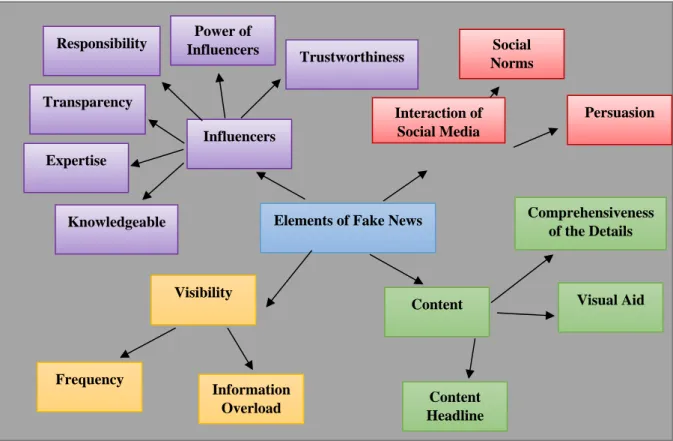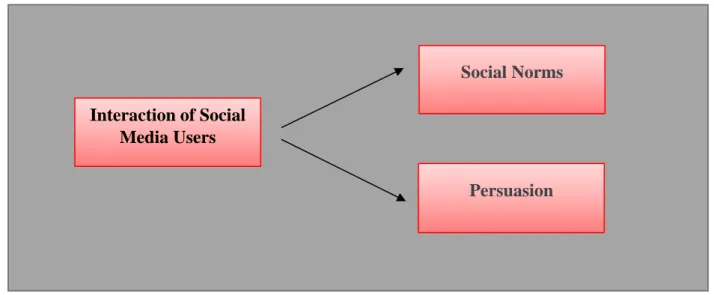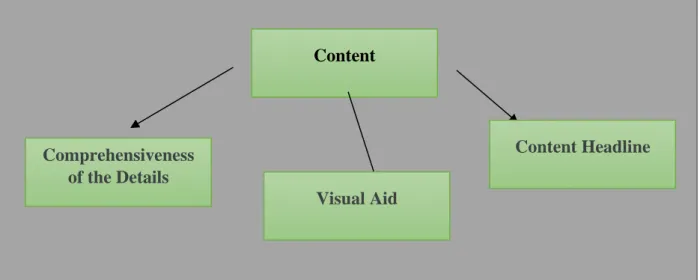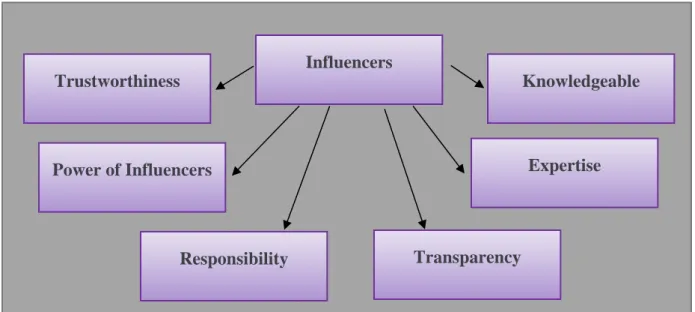Investigating elements of fake news on social media during the COVID-19 pandemic using a heuristic-systematic model. This study aims to uncover the elements of fake news on social media that convince young adults to believe them during the COVID-19 pandemic.
Introduction
Background of Study
Therefore, the issue of spreading fake news on social media is also becoming more common during the pandemic (Ngadiron et al., 2021). Overall, this research identifies the elements of fake news on social media that persuade young adults to believe them during COVID-19.
Research Questions
Significance of the Study
By conducting this research, we also contribute to its practical significance by helping policymakers understand the elements of fake news. This research proves how important it is to teach the young person to recognize the element of fake news in social media.
Research Gap
Our literature review shows that most of the studies conducted by local researchers are more focused on the motives for sharing fake news rather than analyzing the element of fake news. Therefore, the lack of knowledge in identifying the element of fake news has resulted in the young community.
Operational Definition .1 Fake News
Social Media
Social media is an application program that acts as an interface through which users can interact while creating, updating and sharing news, text, graphic and audio information, and rating and promoting existing content (Selwyn, 2012). . Social media users can share, like and forward ideas, as well as spread news.
Young Adult
Although social media platforms were originally designed to connect people, they have evolved into an important means of producing and sharing information and news (Tandoc et al., 2017). Therefore, it is considered that young people have the easiest access to digital media (Pérez-Escoda et al., 2021).
Heuristic-Systematic Model
Introduction
Social Media Use and Young Adults
In addition, the Secretary-General of the Ministry of Communications and Multimedia, Datuk Seri Mohammad Mentek stated that there are approximately 28 million social media users in Malaysia as of January 2021 (The Star, 2021). According to the 2018 MCMC Internet User Survey, the demographics of Malaysian young adult internet users as of July 2018 would be 8.1% under 20 years of age, with a maximum of 30%.
Fake News and COVID-19 Pandemic
Similar to the COVID-19 pandemic, misinformation and false information including fake news about the disease and a large number of conspiracy theories have occurred across social media platforms (Goh, 2021). The number of fake news being spread in the pandemic has increased greatly in Malaysia.
Fake News and Young Adults
Media literacy is important for people of all ages who read or listen to the news, as it enables people to make informed decisions. In addition, media literacy can be divided into several different abilities, such as the ability to access media messages, evaluate media messages, analyze media messages, act on media messages and communicate media messages (Livingstone, 2003).
Fake News and Social Media
- The Heuristic-Systematic Model, an Introduction
- The Development of the Heuristic-Systematic Model
- Heuristic Processing
- Credibility Judgement
- The Heuristic-Systematic Model and the Elements in Fake News
- Heuristic-Systematic Model Application
Today, the spread of fake news is becoming one of the biggest concerns around the world (McGonagle, 2017). The heuristic-systematic model is one of the examples in the theory of dual processing (Chaiken, 1980).
Introduction
Research Design
31 open to new ideas that may emerge during the interview based on the answers of the interviewees (Wageningen University and Research, n.d.). Given that semi-structured interviews are more likely to include open-ended questions and discussions that may deviate from the interview guide. As the semi-structured interviews involved open-ended questions and discussions, yes, no or habitual answers were avoided.
Sampling Procedure
In other words, the researcher has the power to decide what kind of participant he needs in this research, and whether he is able to provide the researchers with information relevant to the topic. With everything changing to online, the amount of time these students have spent on the internet is increasing, which also maximizes their exposure to the negativity online, such as fake news. Young adults who are not currently studying and working have also been forced by the virus to work from home, making their risk of being exposed to negativity online just as high as the students.
Data Collection
That's why we made question number one to ask the interviewees if the number of likes is one of the elements that persuades them to believe in it. That's why we created question number three to determine if the length and details of a message are one of the elements that convince people to believe in it. So we made question number four to determine if people have the expert heuristic when they believe the information of the post posted or shared by the media influencers or people in authority, to prove that the expert heuristic one of the elements is that it persuades people to believe in the fake news.
Data Analysis
It is important to be familiar with all the data obtained so that we do not end up confused when doing the analysis and writing the report afterwards (Braun & Clarke, 2012). The fourth step is where we reviewed all of our data and the steps we performed above. The objective of our research is to identify the element of fake news through qualitative research and here we began the process of naming the themes or categories into which we differentiated our data with an appropriate label that suited our objectives.
Reliability and Validity
Reliability
38 Last but not least, which is the sixth step is to continue writing our analysis. This step is the last of our analysis process, where we have combined everything into a complete report explaining our overall findings.
Validity
Ethical Considerations
The consent form or any document containing the personal details of participants is kept safe, no one has the right to access it except the researchers in the team. Research participants were guaranteed to keep the data collected during the interviews and observations confidential.
The Pilot Study
Advantages of Telephone Interview
Therefore, telephone interviews can be used to interview persons who are unable to attend the interview session due to their location (Block & Erskine, 2012). In addition, telephone interviews consume less time than face-to-face interviews (Sobo et al., 2003). As a result, telephone interviews can help them reduce social pressure and build rapport at the same time (Vogl, 2013).
Introduction
Demographics of the Informants
46 A total of 25 informants were interviewed, of which 14 were women and 11 were men.
Stages of Thematic Analysis
Interaction of Social Media Users
Social Norms
According to her, the number of likes is playing a role in determining how we perceive the credibility of a social media post or account. Because when a lot of people like something, then people can infer that the post must be accurate or have higher credibility. Because we tend to let people, or a number of likes, determine what we want to perceive the credibility of the social media post or account…” [Informant 13].
Frequency
This is because if the information is able to spread so much but is not stopped or criticized by the users, it has a greater possibility of being genuine." [Informant 11]. If it is often displayed on many social media platforms , the government will definitely notice and they will take action if it is fake news.” [Informant 15].
Information Overload
Content
Content Headline
An attention grabber is a tool used to grab people's attention and get them interested in your content.
Influencers
- Power of Influencers
- Responsibility
- Transparency
- Expertise
Based on the findings, the interaction between social media users, visibility, content and influencers are the elements of fake news on social media that lead young adults to believe it during the COVID-19 pandemic. Last but not least, the influencer is also the element of fake news on social media. This chapter discusses the 4 elements of fake news which are "interaction between social media users", "visibility".

Discussion
- Interaction of Social Media Users
- Visibility
- Content
- Influencers
- Practical Implication
- Theoretical Implication
The content is one of the elements of fake news on social media that leads people to believe it. In short, the content is one of the elements that make people believe in fake news. Influencer is one of the elements in fake news on social media that makes young adults believe in it.
Conclusion
The study examined four elements of fake news on social media and how these elements of fake news on social media persuade young adults to believe in them during the COVID-19 pandemic. Fake news and Covid-19: modeling the predictors of fake news sharing among social media users. To Share or Not to Share: The Underlying Motives of Sharing Fake News Amid the Covid-19 Pandemic in Malaysia.
Fake news sharing on social media: applying the honeycomb framework and the third-person effect hypothesis. Young adults' ability to detect fake news and their new level of media literacy in the wake of the Covid-19 pandemic.
Are you aware of the current COVID-19 pandemic that is happening?
How frequent you use the social media account during the Covid-19 pandemic?
How do you get the information about the Covid-19 during the pandemic?
Between a lesser liked post on social media and a highly liked post on social media?
If there is the logo or trademark of the government or official organization in the posts, will you believe the information that is on the post? Why do you trust/not
101 this logo and trademark on fake news to make people believe their news is real. We see a lot of posts taking advantage now, such as using the logo or trademark to make people believe that their news is real, but is actually fake news. It is quite important to check the origin of the news and the account that shared the news.
When the information is appearing in more social media platform, will it make you feel that the information is more reliable and why is that so?
When the information appears in more social media platforms, it will make you feel that the information is more reliable and why is it so.
I think that social media influencers have gained a greater recognition by showing that their authentic, in some way, they will have the greater credibility and influence because of the great exposure of their daily activity. For example, if we compare social media influencers with celebrities, people will tend to follow those influencers because they are more related to us in terms of their lifestyle to share their daily activity. Interviewer: For those who are expert in specific field, I think their content is more creditable because they have the knowledge of the facts.
Do you think that it is easier for you to believe in the news that you lack the certain knowledge? Do you have related experience?
For us, we don't have the knowledge, so we tend to listen and will follow those who have the knowledge in that area. People will be more persuasive and accomplish more with the content those experts have shared. Do you think it is easier for you to believe in the news that you lack the certain knowledge.
Are you more willing to believe the information that fits your opinions? Do you think that the information bias plays a part in this?
Had you been misinformed because you do not analyse the information carefully?
Do emotions lead you to believe in fake news or does emotion not really matter for you to justify the accuracy of the information?
In your opinion, what other elements will make you think the news is believable?


